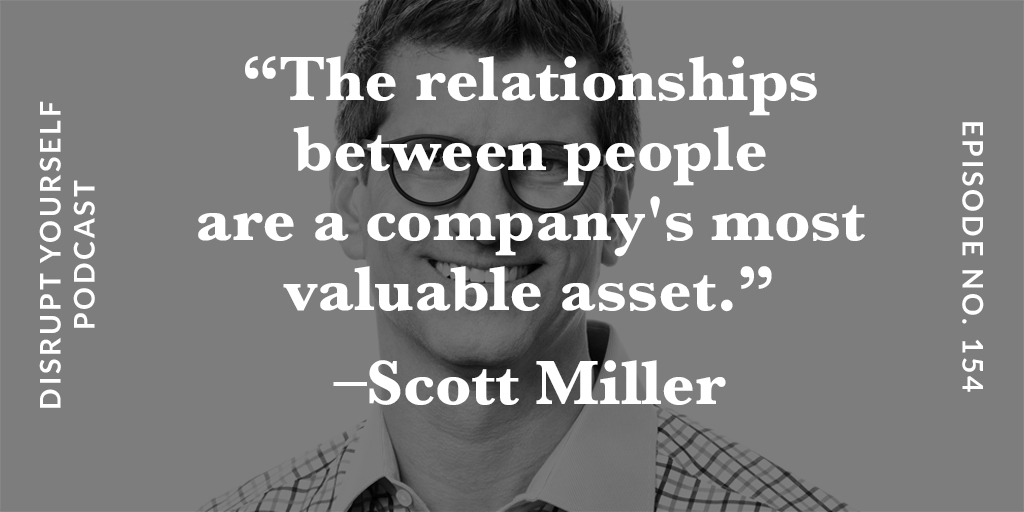Our guest today is Scott Miller. Scott is the Executive Vice President of the Thought Leadership practice at FranklinCovey. Scott is a twenty-three veteran of FranklinCovey, which is part of the reason that I wanted you to hear from him. His 20+ year tenure would suggest that FranklinCovey recognizes that for an organization to get where it wants to go, its people need to grow — to practice personal disruption.
Scott faced more than his fair share of struggles on his 20+ year path to leadership success. He has distilled those lessons into his new book, Management Mess to Leadership Success: 30 Challenges to Become the Leader You Would Follow, about becoming the leader you would want to follow.
Before joining FranklinCovey, Scott worked at Disney’s real estate development arm for four years before he was “invited to leave”.
When strong employees are fired, they often need that little nudge from the universe to go out and find new levels of success. Scott believes that’s exactly what happened when he was fired at Disney, which led him to find his voice at FranklinCovey by constantly disrupting himself within that organization.

His advice to others, “disrupt yourself before you are disrupted” because sooner or later, you will be disrupted – by your industry, your employer, or your leader. So why not take control of your career and disrupt yourself as soon as you stop learning and see signs of boredom or inertia?
Join us as we talk about Scott’s journey through his various roles, the biggest challenges he faced in going from individual contributor and aggressive Type-A sales personality to seasoned leader, and get Scott’s hidden gems that can help make you the leader you yourself would want to follow.
Listen to the episode in the player above, or download and enjoy it on iTunes. If you’re so inclined, please leave us a review!
Takeaways from this episode:
- Scott’s first transition – from a top-performing individual contributor to sales manager – was quite a struggle, especially because he was promoted over more experienced peers despite having any management experience himself. He laments that organizations too often promote top individual producers whose competencies and skills are often inversely correlated to their duties as managers. For example, the attributes that made Scott a good salesman – strong confidence, bravado, always competing to win, and outperforming his own team members, worked against him in a leadership role.
- Pointing to the lack of training when managers get promoted, Scott notes that he mistakenly believed that his mandate was to mold his team into high performing clones of himself. He lacked the maturity to be a leader and his tyrannical ways didn’t sit well with his team. He laments that he realized rather late that he had to work with people and get them to perform to the best of their abilities, not be his clones. He had to metaphorically turn the spotlight off of himself, and onto his team, and be the genius-maker in the room.
- Of the 30 challenges Scott mentions in his book, Scott’s favorite is “Listen first.” While great leaders are master presenters and influencers, they are also great at knowing when to shut up and be good listeners. Being a good listener also helped him ask the right questions and get to the root cause on issues much quicker. His biggest advice to people who want to be good leaders is to stop talking and start listening.
- One of the wisest things Scott learned from Dr. Covey is that there are two types of mindsets – the efficiency mindset and the effectiveness mindset. While efficiency definitely has its merits, great leaders know when to be efficient and when to be effective. In all of our relationships, it’s much more mutually beneficial to be effective.
- Another thing Dr. Covey reminded Scott was “with people, fast is slow, and slow is fast.” As Scott matured into his late 40s, he realized that his bias for action was a liability when it came to relationships, friendships, marriage and parenting. So he urges people to “make time for relationships” (#10 on his list of 30 challenges).
- Tellingly, Scott debunks the workplace adage that “people are every company’s most valuable asset”. Instead, relationships between people are a company’s most valuable asset. You can copy patents, logos, technology, etc., but you cannot copy how people work well together, how they diffuse conflict, or how their skillsets complement each other.
- He also notes that people don’t quit their jobs; they quit their bosses, they quit their work cultures, but they don’t quit leaders who love and care about them.
- Speaking of S-curve disruptions, with no marketing experience, Scott left sales to lead marketing, a department that’s typically seen as the nemesis of sales. But he succeeded as a marketer because he innately understood the importance of sales, revenue and clients to an organization. As Chief Marketing Officer, he worked closely with the head of sales to drive revenue for the greater good of the company.
- Scott advices young leaders to similarly take on lateral roles so they can understand multiple aspects of the business and be more effective as leaders, as opposed to wanting to “slingshot” up the ladder within their area of expertise.
- Humility is another key to leadership success. As Dr. Covey says, “Humble leaders are more concerned with what is right than being” Scott attributes Clayton Christensen’s book, How Will You Measure Your Life?, to helping him understand and value humility. You can be charismatic and be humble. You can be loud and still be humble. Humility comes from confidence. It’s arrogant people who are incapable of showing humility.
- While Scott’s career transitions haven’t been defined by pivotal moments, his marriage made him the success he is today. His wife was a bit of a governor. She’d tell him, “You can’t say that! You can’t wear that! You can’t do that! You said what?” That’s not to say that everyone should marry, but it helps to have an honest coach and guide who can hold a mirror up to what it’s like working with you and being around you.
- Scott refers to Liz Wiseman’s seminal book, Multipliers: How the Best Leaders Make Everyone Smarter, which talks about the need to not be the smartest person in the room. Challenge #21 in his book tells readers to allow others to be smart. Scott’s desire to be the smartest kept him from hiring people who were more talented than him because he was too insecure, and this held him back. He realized, perhaps a bit late, that his job was to attract and retain the best talent possible and let people flourish beyond him.
- Scott struggles the most with Challenge 19: protect your team against urgencies. He cautions against always working in firefighting mode. True leaders protect their teams, not just from outside urgencies, but also from their own artificially created deadlines and urgencies.
Links Mentioned in this Episode:
- Scott Miller – Twitter | LinkedIn
- The Seven Habits of Highly Effective People: Powerful Lessons in Personal Change by Stephen R. Covey
- On Leadership with Scott Miller
- Management Mess to Leadership Success: 30 Challenges to Become the Leader You Would Follow by Scott Jeffery Miller
- Disrupt Yourself: Master Relentless Change and Speed Up Your Learning Curve by Whitney Johnson
- Disrupt Yourself Podcast – Episode 102: Liz Wiseman
- How Will You Measure Your Life? by Clayton Christensen, James Allworth and Karen Dillon
- Think and Grow Rich by Napoleon Hill
- Multipliers: How the Best Leaders Make Everyone Smarter by Liz Wiseman
- FranklinCovey
- Management Mess to Leadership Success website

